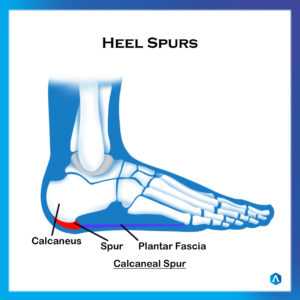Heel Spurs
- Edgard Diaz
- August 19, 2019

Heel spurs can be the result of over exercising and extension of the plantar fascia muscle on the base of the foot. It is a common condition for professional athletes and those who love sport. Being overweight and putting too much force on the heel can also cause heel spurs. It can also be due to the constant traction and pull on the plantar fascia (repetitive in nature) that causes initial tears and later becomes calcified.
Having a heel spur in one foot can be also relate to leg length discrepancy, where the longer leg compensates by pronating more. This can cause a tear and inflammation at the heel attachment, and eventually scarring and calcification, hence calcaneal spur formation.
Symptoms
The main symptom of heel spurs is heel pain, although sometimes spurs are not painful but can be felt.
When waking-up in the morning or rising from a chair, pain can be felt in the foot for a few minutes before then it subsides.
Assessment
To confirm you have heel spurs its best to get a full biomechanical assessment with your podiatrist and an x-ray will show the length of any bony protrusion so the correct treatment can be prescribed.
Treatment
Treatment can include stretching, footwear changes, strapping, foot mobilisation or orthotics. Over the counter anti-inflammatory medication may also help.
- Massage – even though many practitioners recommend stretches for the plantar fascia, at Dr Abbie Clinics we believe the cause can sometimes be over stretching of the plantar fascia, so plantar fascia massage is recommended.
- Strapping – removes the forces applied to the plantar fascia by the heel spur.
- Foot mobilisation – helps re-align the bones of the foot to reduce the stress on the plantar fascia.
- Orthotic therapy to prevent elongation of the plantar fascia. Ortotics are corrective, medically prescribed innersoles, designed to support, control and align the foot whilst correcting mechanical issues from the feet up, treating the cause. Use of orthotic therapy helps realign the body’s biomechanical structure and control any excess foot pronation, eliminating the pull that occurs. Overall, orthotics help stabilise the heel bone and growth plate to decrease inflammation and pain.
- Dry needling – soft tissue (muscles, tendons, ligaments) can often demonstrate taut bands of tissue – commonly known as trigger points, scar tissue or adhesion areas. This can adversely affect range and quality of motion around joints and muscle ultimately leading to pain and discomfort. An acupuncture needle inserted in and around these taut bands of tissue can instigate a muscle twitch response. The body identifies the needle as a ‘foreign object’ which then will elicit an inflammatory response to the area subsequently breaking down the scar tissue.
- Shock wavetherapy – this uses acoustic waves and compressed air to elicit a kinetic energy response (almost like a hand-held jack hammer). Like dry needling, shockwave therapy can influence soft and hard tissue alike- aiding repair, growth and mobility to reduce chronic inflammation, improve collagen and release trigger points.
- Prolotherapy injections – this is an injection (commonly Hypertonic Dextrose solution or Glucose) used in the treatment of osteoarthritic changes and ligamentous degeneration.
- Anti-inflammatories – can reduce any inflammation caused by the spur and corticosteroid injections for severe cases are another approach.
If you are experiencing these symptoms call 1800 DR ABBIE or email reception@dr-abbie.com to organise an assessment.


